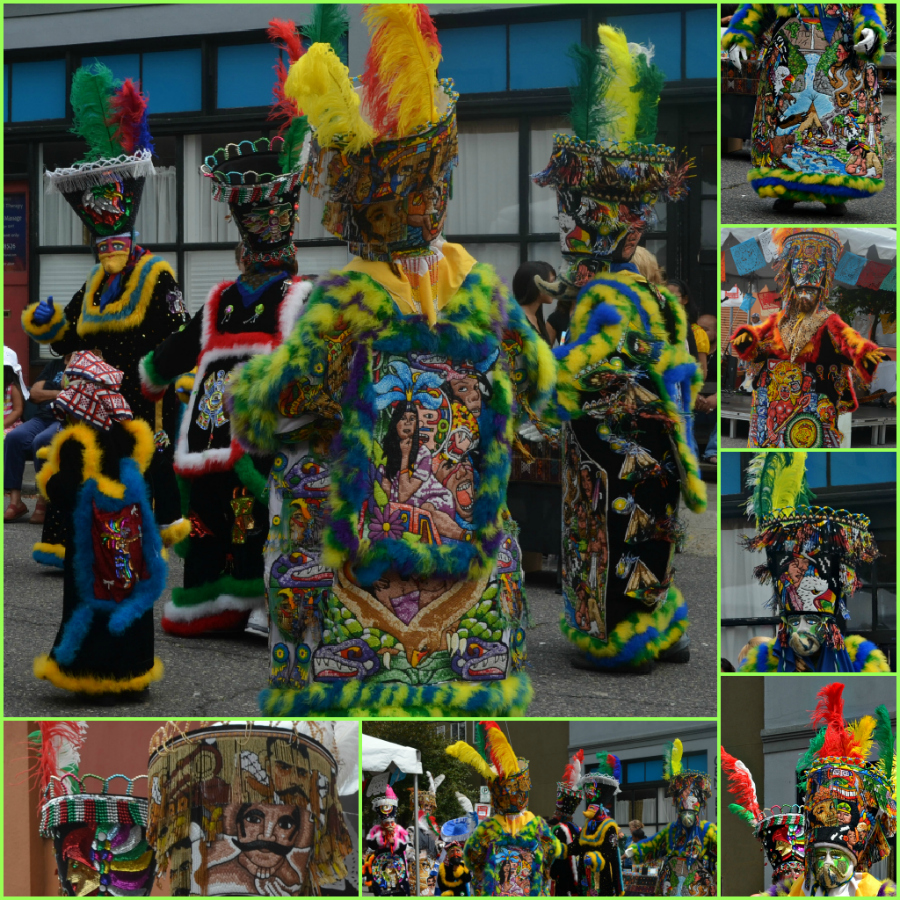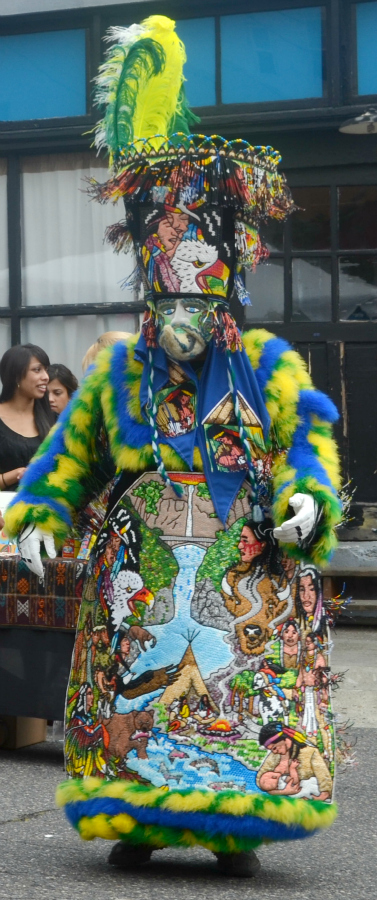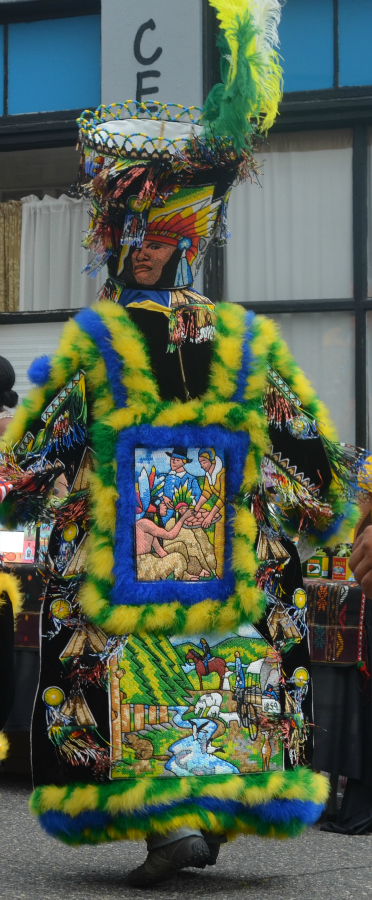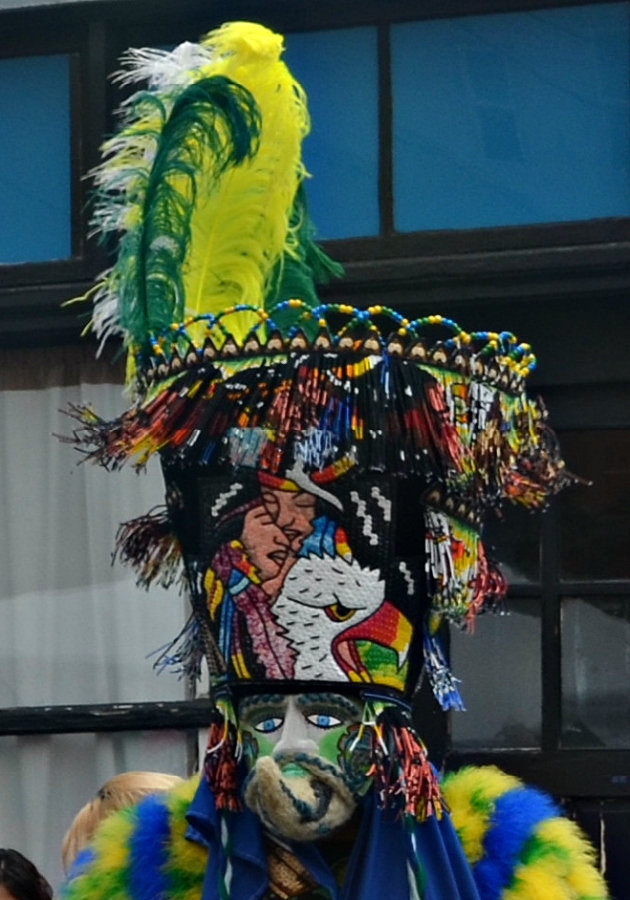
Continuing with one aspect of yesterday's Theme Day post, I decided to bring you another collage, this one just of photos I took on July 29 at the ¡Fiesta en la Calle! Sunday Street Fair in Southeast Portland and sponsored by the Miracle Theatre Group.
I was walking there, after getting off the bus, and could hear the music from several blocks away. All I could think was, "Please keep playing until I get there and for a while after I arrive. Please! I just know someone's dancing to that music!"
Thankfully, the Comparas Orgullo Morelense Cemiac dancers continued. It was hot, so I'm sure they must have been uncomfortable inside those beautiful costumes. And I'm not sure how they can see out of the headdresses, but I surely am glad they figured it out.
To see a superb video about the dancers where their leader and founder Alejandro Mendez Arenales explains the group and why it exists, click here . He also explains his costume and how it depicts aspects of Oregon, his new home. It's so worth viewing, all you have to do is get through a very short commercial.
Here's a great article about the group, published before they marched in the Grand Floral Parade this past June, their first time to participate in the long-time Portland custom. Also, see three cropped images from photos I took on that sunny Sunday.
Rose Festival 2012: Mexican group will bring history, heritage to Grand Floral Parade
By Kelly House, The Oregonian
Alejandro Mendez Arenales puts on the 80-pound costume he will wear while leading the Comparsa Orgullo Morelense Cemiac heritage group in the Rose Festival Grand Floral Parade. Mendez paid nearly $3,000 for an artist to design and hand-bead the Oregon-themed costume in his home state of Morelos, Mexico.



Arenales says Oregon has been good to his people.
The 36-year-old immigrant from Atlatlahucan in Morelos, Mexico, was living in New York 15 years ago when a visit to a friend in Oregon became permanent.
Arenales fell in love with the people, the greenery, the ample space to roam, the water and the fresh air. He married here, had three children and moved into a Southeast Portland neighborhood full of families from his home state. Oregon, he says, welcomed him with open arms.
"I thought I'd stay maybe a few months," he says. "That was in 1997. I never left."
During the June 9 Grand Floral Parade, Arenales and his kinsmen will return the love.
Members of the Morelos heritage group Comparsa Orgullo Morelense Cemiac will march in the parade for their first time, and Arenales will lead the procession dressed in an elaborately beaded costume worth $3,000 that depicts Oregon's history and heritage.
Arenales and a team of helpers have spent more than a year preparing the special costume dedicated to their new home.
Chinelo dancers
The 80-pound gown, mask and headwear covered in beaded murals is a signature of the Chinelo dancers of Morelos, says Jose Ramirez, Arenales' cousin and a member of the group.
"But the U.S.-born children don't know much about the traditions," he says. "Through this group, the youngsters learn, and we can also show other people our traditional dance.
In the parade, 60 Chinelo dancers will wind through downtown Portland in costumes bearing images of Aztec warriors, Mexican flora and fauna, and historical scenes including Emiliano Zapata's assassination.
None will outshine Arenales' walking tribute to Oregon. Green, yellow and blue feathers flutter in the wind while hundreds of thousands of tiny colored beads form stunning images. Native Americans share a meal while bears catch salmon and a beaver wades in the Columbia River. Mount Hood and Multnomah Falls loom in the background. On the back, a pioneer family travels by covered wagon on the Oregon Trail.
"When I moved here, I saw the pine. I saw the beavers, the ducks, the salmon, the rivers, Mount Hood, the people living here," Arenales says. "I wanted to pull them all into the costume."
There are several versions of the lore of Chinelo dancers, but the most popular pegs their origins to the 1870s, when cruel Spanish overlords ruled the indigenous Mexicans. During the Lenten festival of Carnival, the Mexicans took to the streets donning masks and performing a strange dance to mock the Spanish upper class.
Today, the Chinelos are a defining tradition of Morelos, where every child grows up learning the dance.
Portland's Chinelos arose from Arenales' vow to keep the tradition alive in his social circle. When he moved to Oregon 15 years ago, friends often played Chinelo music and danced during gatherings, but he felt uneasy without a costume.
"I said I'll never dance again if I don't have my own costume here in the U.S.A." Arenales says.
Soon after Arenales bought his first costume, friends joined in the effort. Today, the group boasts members throughout the Northwest.
They perform at parades, cultural festivals and in schools but have never marched in the Grand Floral Parade. Arenales had applied twice but was denied a spot in the invitation-only parade both times. He applied early this year and waited eagerly for the April email confirmation that Comparsa Orgullo Morelense Cemiac would be in the lineup.
Highlighting diversity Rich Jarvis, a spokesman for the Rose Festival, says organizers strive to include cultural groups. Along with the Chinelo dancers, groups representing Hawaiian, Vietnamese, Native American and other international communities will march.
"Our focus has been being able to feature and highlight more people and diversity," Jarvis says. "Portland has such rich culture, and we'd like to see that represented more often."
When the invitation came, the Oregon costume still wasn't finished. In the ensuing weeks, a Mexican artist worked furiously to apply the final details.
Ramirez, a retired airline worker who lives in Los Angeles, flew with the costume on a red eye flight from Morelos to Portland, where Arenales retrieved it from the airport. Relieved that the valuable garment had arrived in time and intact, Arenales stayed up most of the night examining the beadwork.
At about $2,700, the Oregon costume is not the most expensive in Arenales' eight-piece collection. The most intricate beadwork can run as high as $12,000, he says. Still, this was no small expense for a working-class father of three. Arenales says it was worth every cent.
"Money can't buy how you feel inside," he says. "The people here, the green, the environment, the friendliness ... it's about love."
On June 9, as the music of his hometown plays and his Morelan comrades perform the sprightly dance of the Chinelos, Arenales will be out front, wearing Oregon on his body and waving its flag in the air.
"It's like Atlatlahucan, Morelos, and Portland, Oregon, sharing two hands," he says. "(The Chinelos) can bring people together. And now Oregon can celebrate it with us." -- Kelly House
No comments:
Post a Comment